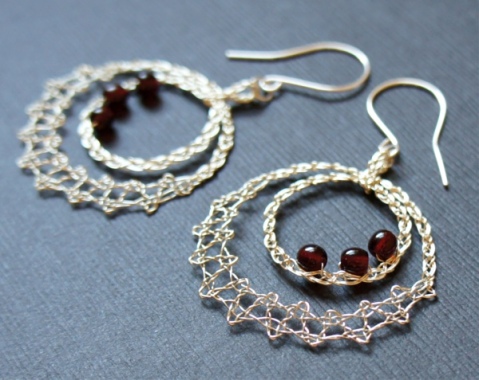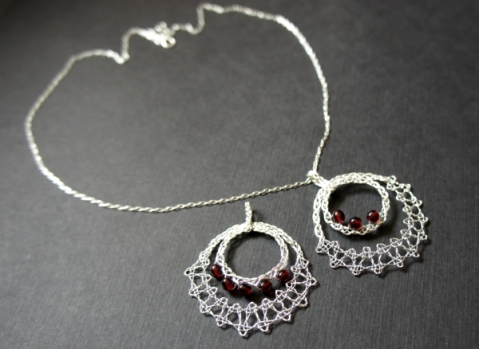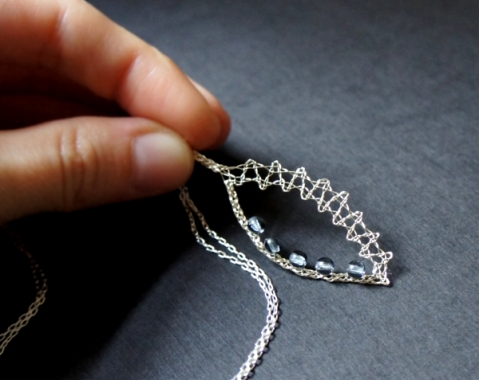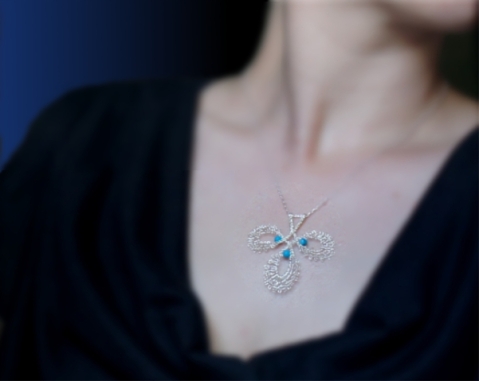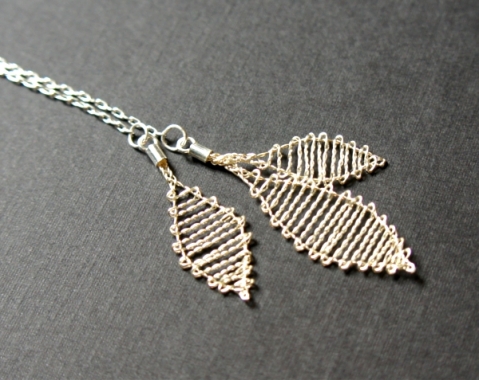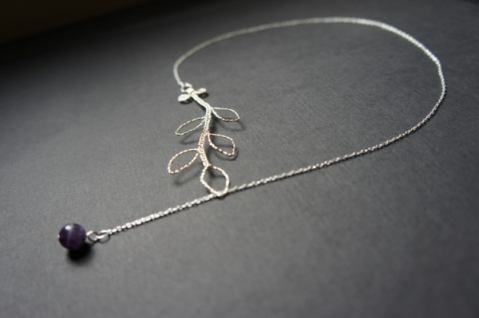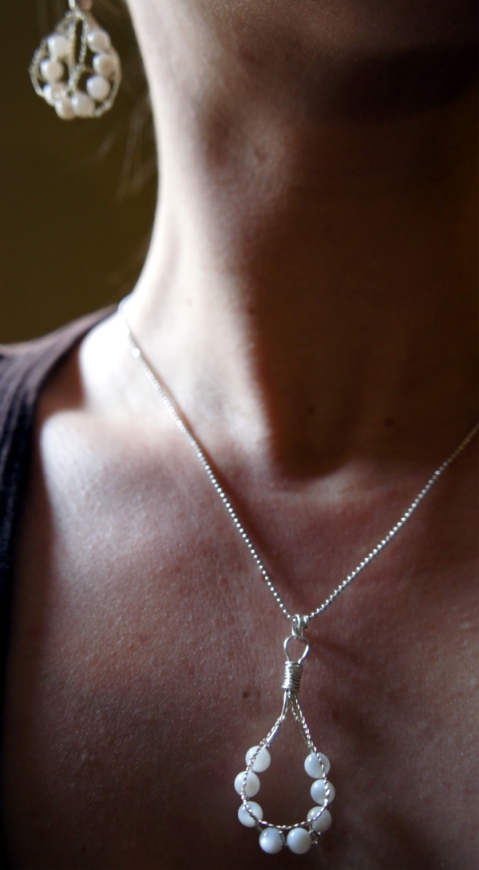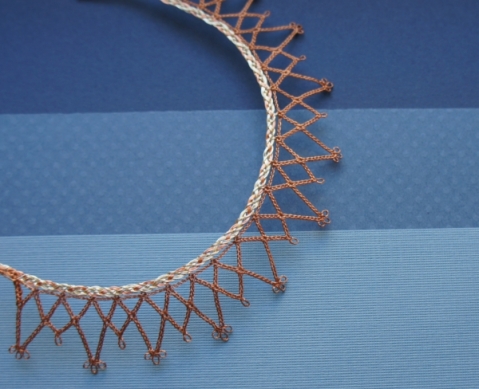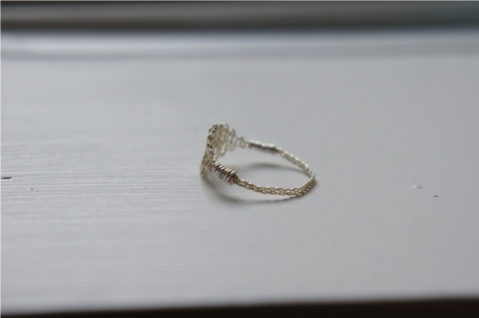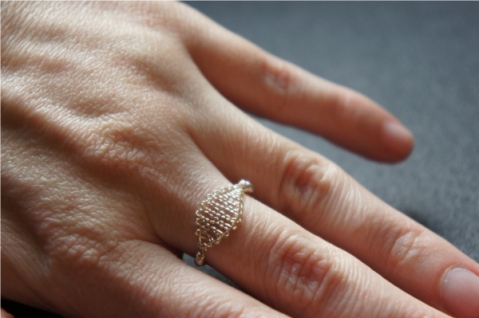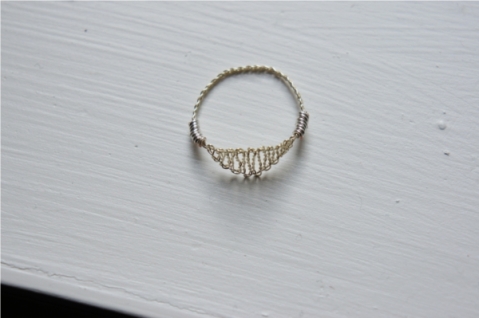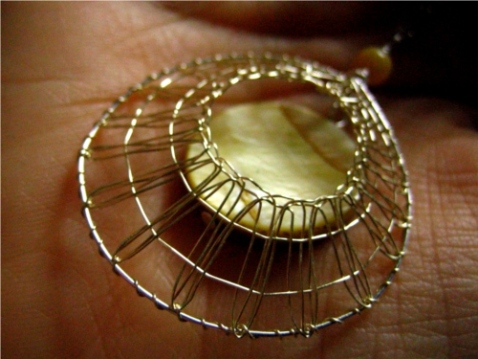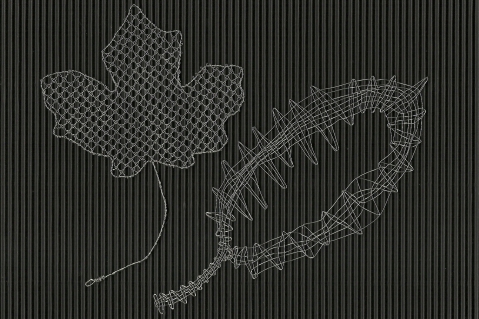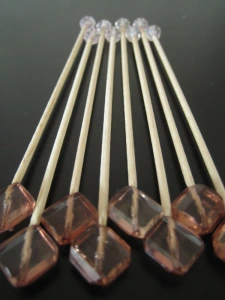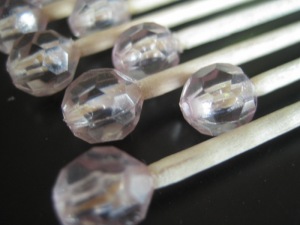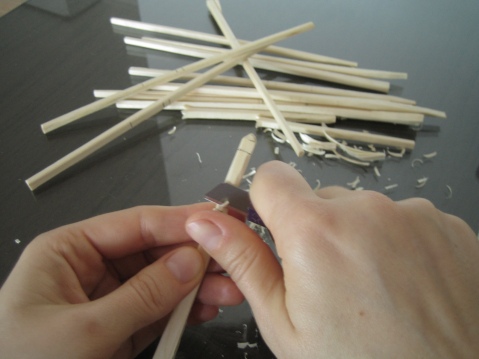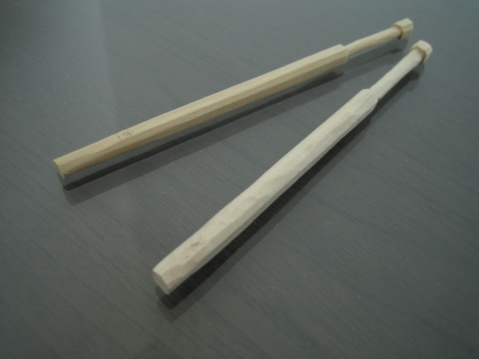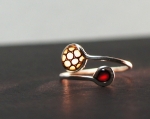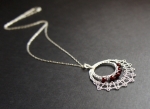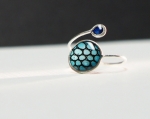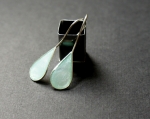green drop earrings
I finished these earrings back in December but didn’t get to photograph them until yesterday.
The lace is made of chocolate-coloured sewing thread woven into a simple half-stitch ground. I simply love the beautiful contrast of the brown lace against the rich yet fresh grass green background of the earrings.

.
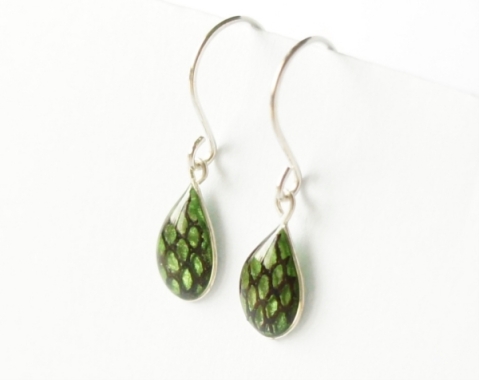
.

.
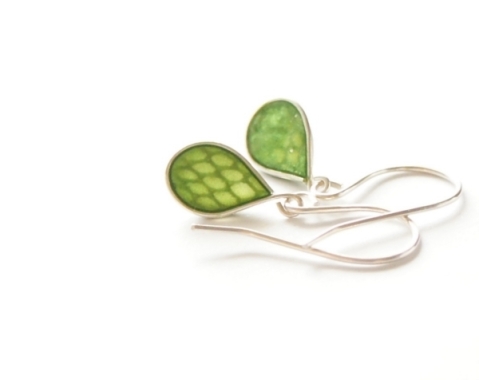
.

everlasting lace ring in turquoise, blue, and chocolate
In the beginning, there were three seemingly random materials: sterling silver wire, resin, and thread.
The lace-maker in me patiently twisted and braided the thread into a piece of bobbin lace just like my great-grandmother used to.
The eager metal-smith in me carefully shaped and finished the wire to form a durable and comfortable ring base, which the free-spirited chemist in me happily filled with custom-dyed resin.
Where past meets present; where tradition meets modernity; where science meets art — that’s where everlasting lace lives. I love knowing that there’s much more to this minimalist ring than what meets the eye.



everlasting lace ring in pearl, red, and chocolate
This ring from the Everlasting Lace series features simple round shapes and minimalist lines that guard droplets of colourful resin with an almost microscopic snippet of handmade lace suspended within.
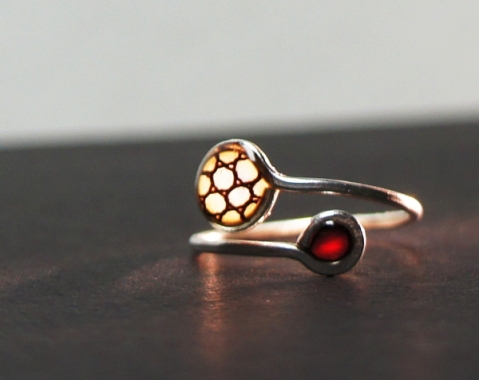

everlasting lace
Simple, colourful resin jewelry.
Handmade, delicate bobbin lace.
What happens when these two media cross paths?
Everlasting Lace is born.
I made the earrings below sometime last October. It was sort of an experiment but it turned out so well that I felt confident giving these to my sister-in-law for her birthday. We aren’t very close and I continue to hope she liked them. Regardless, though – making them was so wonderful! The second I gave them away I knew I’d have to make more.
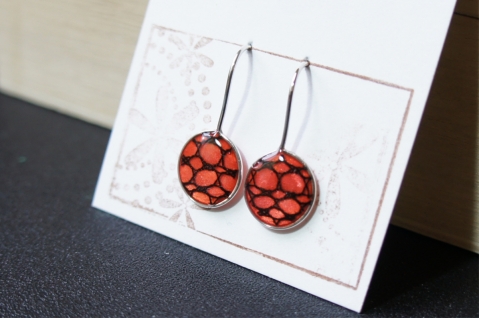

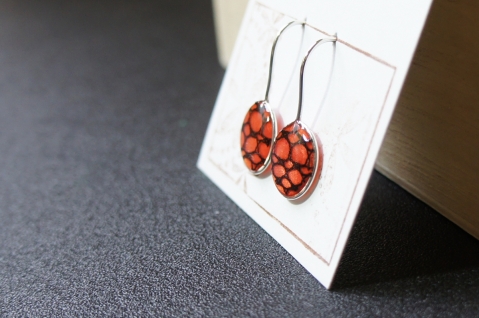
what’s new?
I’m still twisting wire. I also started playing with colour. And resin.
Less lace, more bubbles.
I certainly haven’t been short on ideas. Just short on time needed to post them. Here’s the best of the last three months.
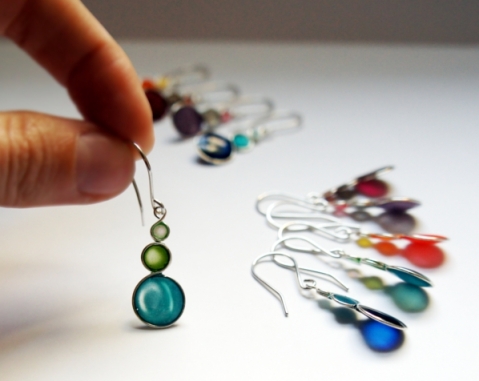
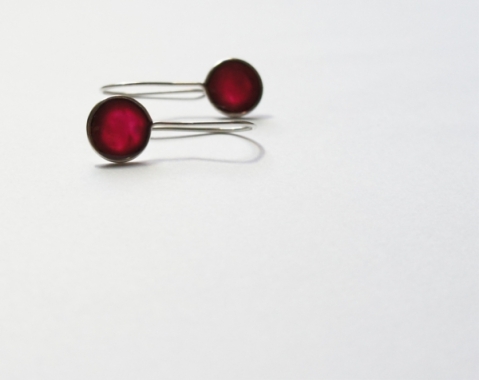
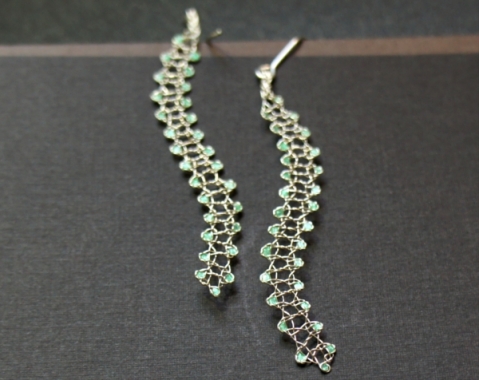
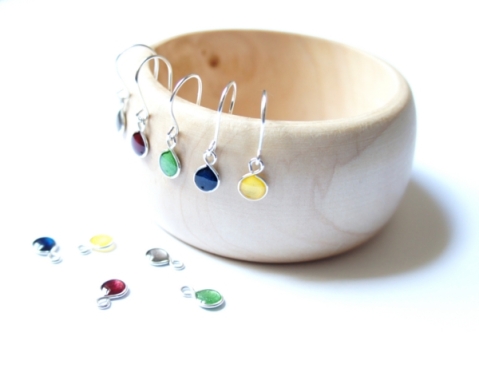
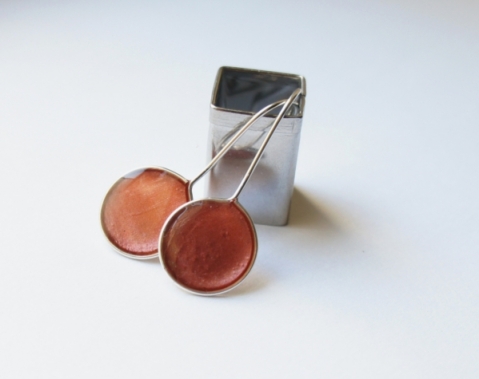

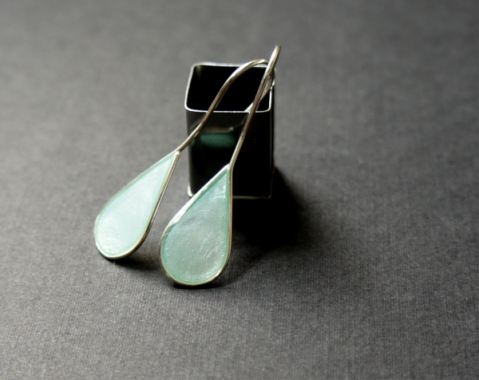
make your own bobbin lace pillow: bolster pillow
I took on bobbin lace-making while living in Korea, out of all places. Far away from home, the Internet became both my teacher and companion.
Inspired by this Russian website (text in English), I made my first bolster pillow using nothing more than a Coke bottle filled with water for weight, batting from an old pillow, and some leftover curtain fabric.
Though it ended up being less than perfect – the amount of batting I had was only about two thirds of what I needed and as a result, the pillow was at places bumpy and soft – I learned many a valuable lesson on it. It also taught me that there is no reason why bobbin lace-making should be an expensive hobby. So far, I have been able to make all that I need (be it bobbins, two bolster pillows or a smaller cookie pillow) with either household items or widely available craft supplies.
I have been using the bolster pillow I made to replace the one I had left behind in Korea for almost a year now, and I love it! It gets its weight from a muslin sack filled with 5 pounds of sand. The core is covered with a single layer of upholstery foam, the edges of which are sewn together. [Had I had more of this foam, I’d have used two layers to end up with a “chubbier” pillow.] The whole thing is furthermore wrapped in 5 layers of black, denser foam sheets. To protect the foam and to provide a washable working surface, the final layer is made out of black knit case, ends of which are firmly tied together.
While the sand makes this pillow really sturdy and stable, it needed a stand that would prevent it from rolling over. Back in Korea, I was using a stiff wine set gift-box and loved it so much that I made my new pillow fit a shoe box I wrapped in some leftover fabric. The box provides just enough support, and stays put not only because of the weight of the pillow, but also thanks to non-slip drawer liner attached to the bottom of it.
To make your own bobbin lace-making pillow, you will need:
- thread, needle, safety pin, sewing machine
- muslin
- 5 lb of sand
- 0.5-inch upholstery foam
- artistic foam sheets
- knit fabric
- string or ribbon
Process:
- Sew a muslin sack to fit a shoebox you want to use. Leave a small opening in one corner.
- On the opposite end, fold both ends over and stitch them together to create a flat bottom.
- Place the sack flat-side down in a mug to keep it stable. Through the opening in the seam, fill it with sand.
- When the sack is packed full, stitch the opening shut.
- Create another flat end by sewing the corners on this side together.
- Measure a rectangle piece of upholstery foam big enough to wrap around the sack. Sew its edges together.
- Wrap the upholstery foam in several layers of denser foam. Test the thickness by pushing a pin through the layers – you should not feel the sand even if the pin is pushed all the way in.
- Sew a knit fabric tube that fits snugly around the pillow. Fold the fabric and create casings on both ends.
- With a safety pin, insert a ribbon through the casings. Tie the ribbon on one end firmly into a knot. Insert the pillow, and tie the other ribbon into a double bow (use this end to wash or replace the cover, when necessary).
- Use your bolster pillow supported by a shoebox. For increased stability, staple or glue a non-slip drawer liner to the bottom of the box.
torchon grid
Note: Written in Seoul in 2009
Another step was making the grid. Though the construction paper seemed to be working, I wanted something that would last a bit longer. So, I gutted a project folder and used the plastic cover.
To make the Torchon grid, I simply punched holes through the plastic laid over the graph paper with a ‘primitive’ pricker I made using a needle super-glued into a chopstick.
make your own bobbins II.
Note: Written in Seoul in 2009
Well, it’s been a busy week. Working in a foreign country, having no locals to ask for advice, and facing a serious language barrier (my knowledge is limited to a few words describing food I like to order when there is no picture menu to point to), I have still managed to create the absolute must-haves if I want to continue learning how to make bobbin lace.
I also realized my practice might be limited to the number of bobbins I own (I made 6 pairs only – making them out of chopsticks was ingenious but a bit time-consuming and, well, it gave me blisters). So I was thinking long and hard about how to make bobbins quickly, easily, and most importantly, without breaking the bank.
All I had to buy were skewers. The rest – superglue, and two kinds of beads – I already had at home. The project was super easy, super quick, and dare I say – the bobbins look awesome!
Here’s how to:
- Cut the skewers into 4 1/2 in (12cm) pieces.
- See if you can bead the skewers. If yes, go to step 3. If not, sharpen both ends into points with an X-acto knife.
- Add a drop of superglue into the smaller of two beads and attach it to the skewer. Repeat on the other end, with the larger bead.
- Let the bobbins dry for at least an hour before starting to use them.
Note, September 26, 2010:
I made 50 pairs of these beaded bobbins last year. I am yet to work on lace that would require that many – but a year and a half and many projects later (including wire lace), I still have all of them. Considering how economical and easy they were to make, they seem indestructible. If you are only learning, or are working with a limited budget, I really recommend you make your own bobbins. I guarantee you will not be disappointed.
